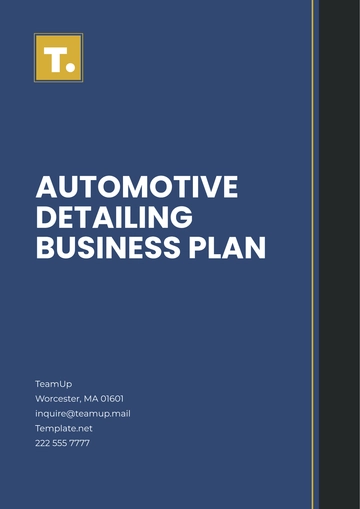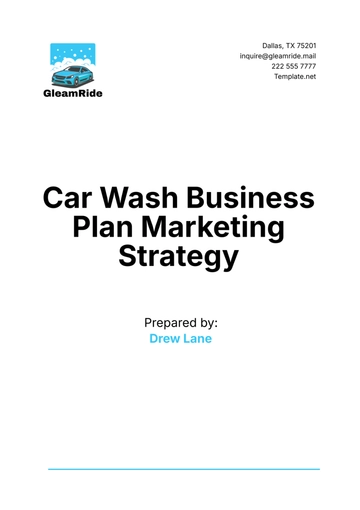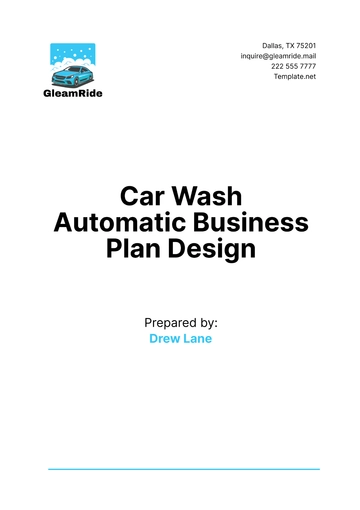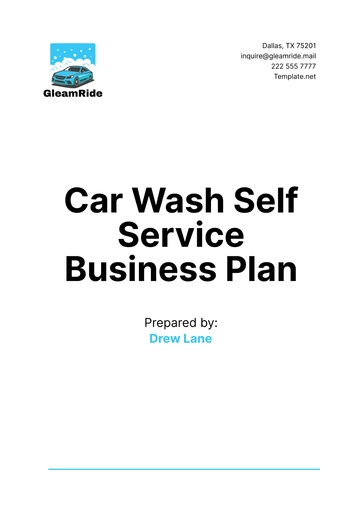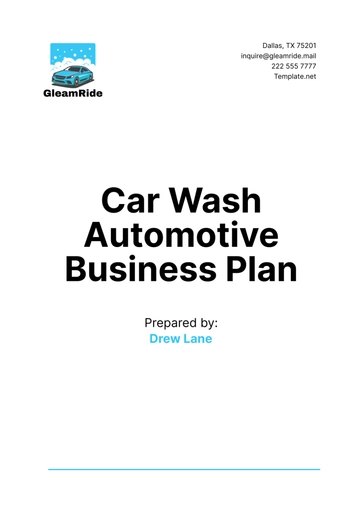Free Blank Car Wash Business Plan Financial Model

1. Executive Summary
[Your Company Name] is planning to establish a premier car wash facility in [City, State], offering high-quality, eco-friendly car wash and detailing services. This financial model outlines our projected revenue, expenses, and profitability, providing a comprehensive framework for financial planning and investment analysis. With an initial investment of $500,000, we aim to achieve profitability within the first year of operations.
1.1 Business Objectives
Achieve a Monthly Revenue of $50,000 Within the First Year
The primary financial goal for [Your Company Name] is to reach a monthly revenue of $50,000 within the first year of operations. This objective is based on a detailed market analysis that identifies a significant demand for high-quality car wash services in [City, State]. To achieve this target, the company will employ several strategies:
Service Diversification: Offering a range of services including basic car washes, premium washes, full detailing, and additional value-added services like engine cleaning and headlight restoration. Each service tier is designed to cater to different customer needs and budgets, maximizing revenue opportunities.
Promotional Campaigns: Implementing aggressive marketing campaigns to attract initial customers. This includes discounts, loyalty programs, and partnerships with local businesses to drive traffic to the car wash.
Customer Retention Programs: Developing membership and subscription plans to ensure recurring revenue. These programs will offer customers incentives such as unlimited washes and discounts on detailing services, encouraging repeat visits.
High Traffic Location: Selecting a prime location with high visibility and accessibility to capture a steady flow of customers. The chosen site will be strategically located near residential areas, commercial hubs, and busy roads to maximize footfall and drive-in traffic.
Build a Loyal Customer Base of 1,000 Recurring Clients by the End of the First Year
Building a loyal customer base is crucial for the long-term success of [Your Company Name]. A target of 1,000 recurring clients by the end of the first year is ambitious but achievable through the following approaches:
Exceptional Customer Service: Providing top-tier customer service to ensure a positive experience for every client. This includes friendly staff, quick service, and a comfortable waiting area with amenities such as free Wi-Fi and refreshments.
Quality Assurance: Maintaining high standards of service quality consistently. Regular training for staff and stringent quality checks will ensure that every car leaves the facility in pristine condition.
Feedback Mechanism: Implementing a robust feedback system to gather customer opinions and improve services. This will include follow-up emails, surveys, and direct feedback channels to address any issues promptly and enhance customer satisfaction.
Community Engagement: Participating in local events and community activities to build brand awareness and foster a strong connection with the community. Sponsoring local sports teams, hosting car wash fundraisers, and engaging in charitable activities will help establish a loyal customer base.
Implement Eco-Friendly Car Wash Techniques to Reduce Water Usage by 40%
Sustainability is a core value for [Your Company Name]. The goal to reduce water usage by 40% will be achieved through the implementation of eco-friendly car wash techniques:
Water Recycling Systems: Installing advanced water recycling systems that filter and reuse water, significantly reducing overall water consumption. These systems can recover up to 85% of the water used, contributing to substantial savings and environmental benefits.
Biodegradable Cleaning Products: Using only biodegradable and non-toxic cleaning agents that are safe for the environment. These products will ensure that no harmful chemicals are released into the water system, protecting local ecosystems.
Efficient Equipment: Utilizing energy-efficient and water-saving equipment such as low-flow nozzles and high-pressure washers that minimize water usage while maintaining cleaning effectiveness.
Employee Training: Training staff on best practices for water conservation and proper use of equipment. This includes techniques to minimize water waste and maximize efficiency during the car wash process.
1.2 Financial Objectives
Generate Annual Revenue of $600,000 by the Second Year
Achieving an annual revenue of $600,000 by the second year is a key financial milestone for [Your Company Name]. This target will be met by:
Scaling Operations: Expanding service offerings and optimizing operations to handle a higher volume of customers. This includes extending operating hours, adding more service bays, and hiring additional staff to meet increased demand.
Market Penetration: Increasing market penetration through targeted marketing efforts, including digital marketing, social media advertising, and local partnerships. These efforts will raise brand awareness and attract a broader customer base.
Customer Loyalty Programs: Strengthening customer loyalty programs to encourage repeat business and increase average transaction value. Offering exclusive deals, rewards, and referral bonuses will drive customer retention and acquisition.
Maintain a Gross Profit Margin of at Least 60%
Maintaining a gross profit margin of at least 60% is essential for the financial health of [Your Company Name]. This will be achieved by:
Cost Control: Implementing strict cost control measures to keep expenses in check. This includes negotiating favorable terms with suppliers, bulk purchasing, and minimizing waste.
Efficient Operations: Streamlining operations to improve efficiency and reduce labor costs. Utilizing advanced technology and automated systems will enhance productivity and lower operational costs.
Premium Pricing: Offering premium services that justify higher pricing, thereby increasing the average revenue per customer. This includes exclusive detailing packages, eco-friendly services, and value-added options.
Achieve a Break-Even Point Within the First Six Months of Operations
Reaching the break-even point within the first six months is a critical financial objective. This will be facilitated by:
Strong Initial Marketing: Launching a strong initial marketing campaign to attract customers quickly and generate immediate revenue. This includes grand opening promotions, discounts, and extensive advertising.
Revenue Management: Closely monitoring revenue streams and adjusting strategies as needed to ensure steady cash flow. This includes optimizing service offerings and pricing based on customer demand and market trends.
Expense Management: Keeping initial expenses low by focusing on essential expenditures and delaying non-critical investments until the business is more established. This includes leasing equipment instead of purchasing and hiring part-time staff initially.
By meeting these business and financial objectives, [Your Company Name] aims to establish a profitable and sustainable car wash business that delivers exceptional value to customers while promoting environmental stewardship.
2. Startup Costs
The startup costs for [Your Company Name] include expenses related to facility setup, equipment purchase, marketing, and working capital.
Expense Category | Estimated Cost ($) |
|---|---|
Facility Lease | 50,000 |
Equipment Purchase | 200,000 |
Renovation and Setup | 100,000 |
Initial Inventory | 20,000 |
Marketing and Advertising | 30,000 |
Working Capital | 50,000 |
Total | 450,000 |
3. Revenue Projections
3.1 Revenue Streams
[Your Company Name] will generate revenue through a variety of services, including car washes, detailing, memberships, and additional value-added services.
Revenue Stream | Monthly Revenue ($) | Annual Revenue ($) |
|---|---|---|
Car Wash Services | 30,000 | 360,000 |
Detailing Services | 10,000 | 120,000 |
Membership Programs | 5,000 | 60,000 |
Additional Services | 5,000 | 60,000 |
Total | 50,000 | 600,000 |
3.2 Sales Forecast
The sales forecast projects revenue growth over the first three years of operations.
Year | Revenue ($) | Growth Rate (%) |
|---|---|---|
2050 | 300,000 | |
2051 | 600,000 | 100 |
2052 | 720,000 | 20 |
4. Cost of Goods Sold (COGS)
4.1 COGS Breakdown
The cost of goods sold includes expenses directly related to providing car wash and detailing services.
Expense Category | Monthly Cost ($) | Annual Cost ($) |
|---|---|---|
Cleaning Supplies | 3,000 | 36,000 |
Water and Utilities | 2,000 | 24,000 |
Labor Costs | 10,000 | 120,000 |
Maintenance | 2,000 | 24,000 |
Total | 17,000 | 204,000 |
4.2 Gross Profit
Gross profit is calculated by subtracting the cost of goods sold from total revenue.
Year | Revenue ($) | COGS ($) | Gross Profit ($) | Gross Profit Margin (%) |
|---|---|---|---|---|
2050 | 300,000 | 120,000 | 180,000 | 60 |
2051 | 600,000 | 204,000 | 396,000 | 66 |
2052 | 720,000 | 244,800 | 475,200 | 66 |
5. Operating Expenses
Operating expenses include all costs required to run the business that are not directly tied to the production of goods or services.
5.1 Operating Expenses Breakdown
Expense Category | Monthly Cost ($) | Annual Cost ($) |
|---|---|---|
Rent | 5,000 | 60,000 |
Salaries and Wages | 8,000 | 96,000 |
Marketing and Advertising | 3,000 | 36,000 |
Insurance | 1,000 | 12,000 |
Office Supplies | 500 | 6,000 |
Miscellaneous | 500 | 6,000 |
Total | 18,000 | 216,000 |
5.2 Operating Profit
Operating profit is calculated by subtracting operating expenses from gross profit.
Year | Gross Profit ($) | Operating Expenses ($) | Operating Profit ($) | Operating Profit Margin (%) |
|---|---|---|---|---|
2050 | 180,000 | 108,000 | 72,000 | 24 |
2051 | 396,000 | 216,000 | 180,000 | 30 |
2052 | 475,200 | 259,200 | 216,000 | 30 |
6. Net Profit
Net profit is the final profit after all expenses have been deducted from total revenue.
6.1 Net Profit Calculation
Year | Operating Profit ($) | Taxes ($) | Net Profit ($) | Net Profit Margin (%) |
|---|---|---|---|---|
2050 | 72,000 | 14,400 | 57,600 | 19.2 |
2051 | 180,000 | 36,000 | 144,000 | 24 |
2052 | 216,000 | 43,200 | 172,800 | 24 |
7. Cash Flow Statement
7.1 Cash Flow from Operations
Year | Net Profit ($) | Depreciation ($) | Change in Working Capital ($) | Cash Flow from Operations ($) |
|---|---|---|---|---|
2050 | 57,600 | 20,000 | -10,000 | 67,600 |
2051 | 144,000 | 20,000 | -15,000 | 149,000 |
2052 | 172,800 | 20,000 | -20,000 | 172,800 |
7.2 Cash Flow from Investing
Year | Capital Expenditures ($) | Cash Flow from Investing ($) |
|---|---|---|
2050 | -350,000 | -350,000 |
2051 | -50,000 | -50,000 |
2052 | -50,000 | -50,000 |
7.3 Cash Flow from Financing
Year | Equity Financing ($) | Debt Financing ($) | Interest Payments ($) | Cash Flow from Financing ($) |
|---|---|---|---|---|
2050 | 300,000 | 200,000 | -10,000 | 490,000 |
2051 | 0 | 0 | -15,000 | -15,000 |
2052 | 0 | 0 | -20,000 | -20,000 |
7.4 Net Cash Flow
Year | Cash Flow from Operations ($) | Cash Flow from Investing ($) | Cash Flow from Financing ($) | Net Cash Flow ($) |
|---|---|---|---|---|
2050 | 67,600 | -350,000 | 490,000 | 207,600 |
2051 | 149,000 | -50,000 | -15,000 | 84,000 |
2052 | 172,800 | -50,000 | -20,000 | 102,800 |
8. Break-Even Analysis
8.1 Break-Even Point
The break-even point is calculated by dividing the total fixed costs by the contribution margin ratio.
Expense Category | Monthly Cost ($) | Annual Cost ($) |
|---|---|---|
Fixed Costs (Rent, Salaries) | 13,000 | 156,000 |
Variable Costs (COGS) | 17,000 | 204,000 |
Total Costs | 30,000 | 360,000 |
Metric | Value |
|---|
Contribution Margin (%) | 60 |
Break-Even Point (Monthly $) | 21,667 |
Break-Even Point (Annual $) | 260,000 |
8.2 Break-Even Analysis Summary
To break even, [Your Company Name] must generate $21,667 in monthly revenue or $260,000 in annual revenue. This target is achievable within the first six months of operation, considering our projected revenue streams.
9. Sensitivity Analysis
9.1 Revenue Sensitivity
The sensitivity analysis examines how changes in revenue affect net profit.
Change in Revenue (%) | Revenue ($) | Net Profit ($) | Net Profit Margin (%) |
|---|---|---|---|
-20 | 480,000 | 96,000 | 20 |
-10 | 540,000 | 120,000 | 22.2 |
0 | 600,000 | 144,000 | 24 |
+10 | 660,000 | 168,000 | 25.5 |
+20 | 720,000 | 192,000 | 26.7 |
9.2 Expense Sensitivity
The sensitivity analysis examines how changes in expenses affect net profit.
Change in Expenses (%) | Expenses ($) | Net Profit ($) | Net Profit Margin (%) |
|---|---|---|---|
-20 | 288,000 | 192,000 | 32 |
-10 | 324,000 | 168,000 | 28 |
0 | 360,000 | 144,000 | 24 |
+10 | 396,000 | 120,000 | 20 |
+20 | 432,000 | 96,000 | 16 |
10. Financial Ratios
10.1 Profitability Ratios
Ratio | Year 2050 | Year 2051 | Year 2052 |
|---|---|---|---|
Gross Profit Margin (%) | 60 | 66 | 66 |
Operating Profit Margin (%) | 24 | 30 | 30 |
Net Profit Margin (%) | 19.2 | 24 | 24 |
Return on Assets (ROA) (%) | 11.5 | 18 | 21.6 |
Return on Equity (ROE) (%) | 19.2 | 24 | 24 |
10.2 Liquidity Ratios
Ratio | Year 2050 | Year 2051 | Year 2052 |
|---|---|---|---|
Current Ratio | 3.5 | 3.7 | 3.9 |
Quick Ratio | 2.8 | 3.0 | 3.2 |
10.3 Solvency Ratios
Ratio | Year 2050 | Year 2051 | Year 2052 |
|---|---|---|---|
Debt to Equity Ratio | 1.0 | 0.8 | 0.6 |
Interest Coverage Ratio | 7.2 | 12.0 | 14.4 |
11. Conclusion
This comprehensive financial model provides a detailed roadmap for the financial planning and analysis of [Your Company Name]. The projections, cost breakdowns, and sensitivity analyses ensure that the business is financially viable and can achieve profitability within the first year of operations. By adhering to this financial plan, [Your Company Name] is well-positioned for success in the competitive car wash industry.
For further information, please contact:
[Your Name]
[Your Position]
[Your Company Name]
[Your Company Email]
[Your Company Address]
[Your Company Number]
[Your Company Website]
- 100% Customizable, free editor
- Access 1 Million+ Templates, photo’s & graphics
- Download or share as a template
- Click and replace photos, graphics, text, backgrounds
- Resize, crop, AI write & more
- Access advanced editor
Plan your financial future accurately with Template.net’s Blank Car Wash Business Plan Financial Model Template. Designed for precision and flexibility, this template is editable and customizable with our AI editor tool, providing you with the framework to project revenues, costs, and profitability for your car wash venture. Essential for securing investors and managing budgets effectively.
You may also like
- One Page Business Plan
- Coffee Shop Business Plan
- Restaurant Business Plan
- Food Business Plan
- Real Estate Business Plan
- Executive Summary Business Plan
- Cover Page Business Plan
- Nonprofit Business Plan
- Daycare Business Plan
- Construction Business Plan
- Startup Business Plan
- Medical Business Plan
- Bakery Business Plan
- Service Plan
- Hotel Business Plan
- Catering Business Plan
- School Business Plan
- Healthcare Business Plan
- Transportation Plan
- Sports Plan
- Car Wash Business Plan
- Salon Business Plan
- Clothing Business Plan
- Farming Business Plan
- Boutique Plan
